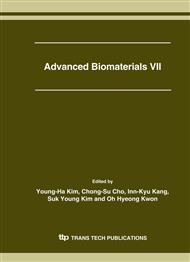p.545
p.549
p.553
p.557
p.561
p.565
p.569
p.573
p.577
A Comparative Study of Porous Titanium with Different Surface Modification Implanted in Dogs
Abstract:
This study was carried out to investigate the effect of acid-alkali treatment and alkaliheat treatment on the push-out strength and tissue response of the porous titanium in vivo. Porous titanium with different treatment was implanted in dog bony site for 2 months and 5 months and the push-out strength was tested. At 2 months, the mean push-out strengths of the acid-alkali treated and alkali-heat treated porous titanium were 11.3 and 15 MPa, respectively. At 5 months, the values reached 29.8 and 35 MPa, respectively. Histological observation showed a close contact between implants and bone, and more bone tissue filled inside the pores of porous titanium increasing with implantation time. The results indicated higher bonding strength between bone and porous titanium in alkali-heat treated samples. Therefore, alkali-heat treatment can provide porous titanium implants with better fixation as a bone substitute for clinical use under load-bearing conditions.
Info:
Periodical:
Pages:
561-564
Citation:
Online since:
July 2007
Authors:
Price:
Сopyright:
© 2007 Trans Tech Publications Ltd. All Rights Reserved
Share:
Citation:


